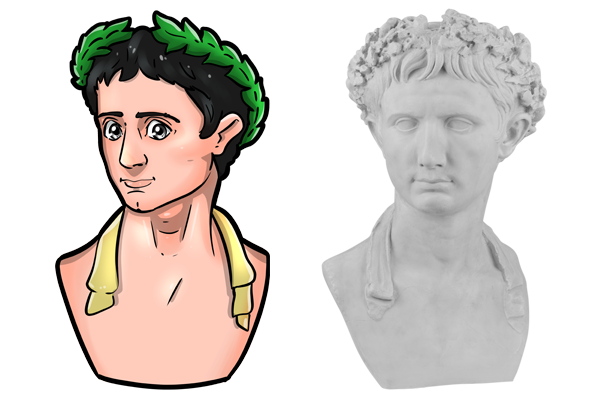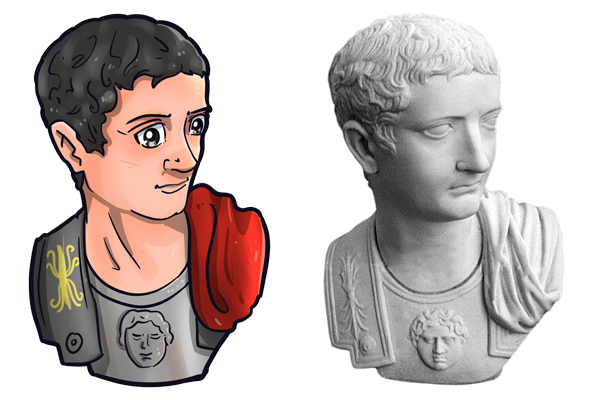Roman emperors
Roman busts of ancient emperors and famous personalities
Roman Emperor Busts. The fully sculpted busts of ancient emperors have been a form of expression for classical personalities since Roman antiquity. Each intricately crafted and lovingly hand patinated Roman bust is a cast or copy of ancient emperors, generals and celebrities.
Ordering & shipping
How fast is the shiping ?
Can I also order on account?
Returns
Do we supply to traders and museums?
Busts of the Roman Emperors
In various sizes and materials, the Roman busts on the busts pages of the Roman Shop offer a wide selection of ancient heads. Decorative busts on polished black marble pedestals can grace your desk, living room or bookshelf in a way that replicas are usually only seen in museums.
Roman busts to decorate
The larger sculptures look particularly impressive on columns or pedestals. For lovers of antiquity, they are a stylish addition to any office, study or living room. In humanistic schools, the images of ancient ancestors can be placed impressively in the staircase or corridors of the educational institution. Be inspired by the sculptural ancient likenesses of the mighty Roman emperors, consuls and generals on the replica Roman busts pages of the Roman Shop!
About the Roman Busts
Roman busts are statues that depict only the head and torso of a person. In ancient times they were usually made of marble or bronze and were intended to enhance the prestige and honour of the person in question. The word bust comes from the French word "buste" and the Italian word "busto" and describes the upper part of the body or, in art, the replica of the human head. The ancient Greeks experimented with busts, but it was not until the Roman Empire that most busts were created.
Roman imperial busts
At the beginning of the imperial period, busts were made with only a small cut-out up to the collarbone. But as time went on, more and more of the upper part of the body was modelled, and the beginnings of the arms were added. In the beginning, the first emperors were always depicted very young and without beards in order to appear ageless. Only later did they become more realistic. The busts were meant to show the character of the person. Clues from the clothing were often used. If men wore a breastplate or a sword belt, they belonged to the military, as in the case of busts of the Emperor Tiberius. If they were also naked underneath, this emphasised their strength and bravery. Wreaths were also widely used. They were worn on the head as a sign of honour. The oak wreath was very popular in Roman antiquity. At first it was given to soldiers who had saved someone in war. But then the emperors claimed the honour for themselves.
Busts were "in", even with oak leaves of Jupiter, the father of the gods.
Emperor Augustus was very often depicted with a wreath of oak leaves, and later emperors were also given the wreath. It was intended to show the Senate's approval of the new emperor and probably also to symbolise world domination, as the oak tree is the symbol of Jupiter, the father of the gods. The busts of the Roman emperors were usually placed in public places, but they were also found in houses, in the Forum and in burial chambers. Above all, the busts of the emperors could be seen everywhere in the streets of Rome. From Roman busts it is possible to deduce what the person looked like and when he or she lived. In the case of the emperors, it is very easy to find out because their busts were distributed all over the country and their heads were also stamped on the coins of the time. It is also interesting to note that busts can also tell us about the fashions of the day in ancient Rome, as the hairstyles of the people depicted can also tell us a lot about them.
The Roman bust
You can discover Roman culture and lifestyle by looking at Roman busts. They are precious finds from ancient times. Recovered by archaeologists under difficult conditions or exhibited in museums in distant countries, the Roman bust tells a long story. Archaeological science attaches particular importance to the bust of the Emperor. It has been established that the making of portraits was an important form of representation in Roman antiquity. However, it has not yet been possible to find out what other function the bust had in society.
Whose face is on the bust?
Not every famous person in Roman antiquity was given the honour of having their own bust. Portraits were mainly made for members of the imperial family. In the Roman Empire, statues of honour were also erected in important places in large cities. The traditional production of busts developed around the year 30 BC, when the emperor Augustus reigned in Rome. It was during his reign that the first marble sculptures were created. They were three-dimensional, showing the head and upper part of the torso. They were made of white marble. It is said that the famous Carrara marble was quarried by the Romans as early as 50 BC. This marble was used by the Romans mainly for the construction of their prestigious buildings in the capital city of Rome. Examples of impressive Roman architecture include the Temple of Dioscuri in the Forum Romanum and the Forum of Augustus, both of which were built with this marble. Trajan's Column is also made of white Carrara marble. In order to preserve and pass on Roman history, replicas of the original busts are often made today. They bring a piece of Roman culture into your own home and offer a glimpse of the ancient world. Roman portraits have long since found their way into our homes as works of art or attractive decorations. Matched to the style of your home, you will find a true-to-life replica of the Roman emperor in your living room.
Valuable tradition
The face of the emperor and his family was not simply reproduced by the artist. The portrait was given the characteristics of an emperor and then the facial expressions were adapted accordingly. After all, the emperor could not be portrayed as a vivacious youth. He had to radiate the sovereignty of a ruler. Portraits of Roman emperors often show serious or introspective features. The people should respect the emperor. In honour, the portrait was often adorned with a crown of oak leaves. Emperor Augustus received this for saving the Roman people.
The Roman bust in your home
Roman portraits were on public display in ancient times. People wanted to see the emperor, if not in person, then at least visually. The portraits of the imperial family were displayed in the squares of the cities. The replicas of Emperor Augustus, Emperor Tiberius, Caesar or the general Gaius Julius Caesar are therefore not only suitable as decorative objects for the home. You can also place them in your garden or on your patio. Bring a piece of Roman history into your home with a valuable Roman bust!
Römische Kaiser - Kurzinfos

Tiberius
Regierungszeit: 14 – 37 n.Chr.
Tiberius wurde im Jahre 18. September 14 n.Chr. als römischer Kaiser deklariert. Obwohl sich Tiberius zuerst sträubte, verlieh der Senat die gleiche Machtfülle wie seinem Vorgänger Octavian, doch er lehnte die Betitelung „Augustus“ ab.
Kaiser Tiberius hatte in seiner Amtszeit mit einer Meuterei der Truppen in Pannonien und Untergermanien zu tun und schickte dafür auch seinen Sohn Drusus den Älteren ins Feld, der an der Donau kämpfte. Als Nachfolger des Tiberius kamen aber am Ende nur die ältesten Söhne des verstorbenen Germanicus und der Agrippina der Älteren in Frage.Kaiser Tiberius hatte in seiner Amtszeit mit einer Meuterei der Truppen in Pannonien und Untergermanien zu tun und schickte dafür auch seinen Sohn Drusus den Älteren ins Feld, der an der Donau kämpfte. Als Nachfolger des Tiberius kamen aber am Ende nur die ältesten Söhne des verstorbenen Germanicus und der Agrippina der Älteren in Frage.
Kaiser Augustus (Octavian)
Regierungszeit: 27 v.Chr. – 14 n. Chr.
Die wohl prägenste Zeit der römischen Geschichte (gemeint ist speziell der Bürgerkrieg) bringt einen Kaiser hervor, der zuerst von seiner Adoption durch Gaius Julius Cäsar auf dem Rückzug von Epireus erfuhr und Rache üben wollte für die Ermordung des mächtigen Kaisers.
Augustus galt als der Sohn des Vergöttlichten („Divi filius“). Später gab er sich selbst als „Imperator“. Vor allem im Krieg mit den Piraten konnte er sich profilieren, da sein Befehlshaber Marcus Agrippa die Seeschlacht vor Naulochos in Mylae 36 v.Chr. gewann.
Desweiteren führte Octavian auch Krieg gegen die Eingeborenen in Dalmatien und Illyrien und schützte Rom damit vor Überfallen dieser Stämme im Nordosten Italiens. Da Octavian das Testament von Antonius unerlaubt veröffentlichte, brach das Triumvirat auseinander.

| Kaiser | Regierungszeit | Infos |
|---|---|---|
Augustus |
27 v.–14 n. Chr. | Gaius Octavius Gaius Iulius |
Tiberius |
14-37 | Tiberius Claudius Nero Tiberius Iulius |
Quellennachweis:
- www.commons.m.wikimedia.org
- www.de.wikipedia.org
- ancient sculpure
Schools and authorities in DE can conveniently order on account. Private customers are welcome to use Ratepay purchase on account (Paypal service)
Safe and easy ordering within Germany from 75 €
Always new ideas and optimised products through our years of experience and intensive cooperation with schools and museums.